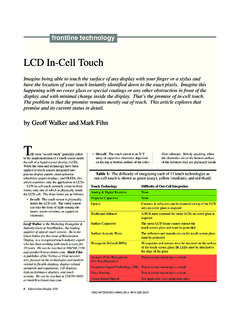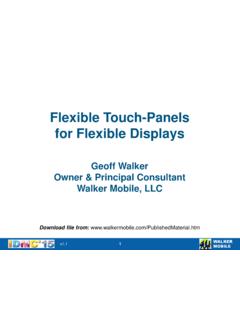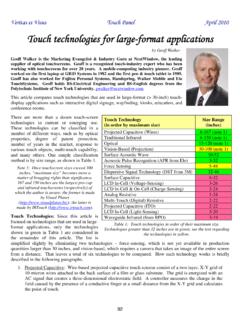Transcription of Fundamentals of Projected-Capacitive Touch Technology
1 DISPLAY WEEK 14 Fundamentals ofProjected-CapacitiveTouch TechnologyGeoff WalkerSenior Touch TechnologistIntel CorporationJune 1, Download: use exact capitalization!DISPLAY WEEK 14 Agenda Introduction Basic Principles Controllers Sensors ITO-Replacement Materials Modules Embedded Large-Format Stylus Software Conclusions Appendix A: Historical Embedded Touch2 DISPLAY WEEK 143 P-Cap History P-Cap Penetration P-Cap by Application Touch User-ExperienceIntroductionFile Download: use exact capitalization!DISPLAY WEEK 14P-Cap History4 Company Significance Year UK Royal Radar Establishment ( Johnson) First published application of transparent touchscreen (mutual-capacitance p-cap on CRT air-traffic control terminals) 1965 CERN (Bent Stumpe) Second published application of mutual-capacitance p-cap (in the control room of the CERN proton synchrotron) 1977 Dynapro Thin Films (acquired by 3M Touch Systems in 2000) First commercialization of mutual- capacitive p-cap (renamed as Near-Field Imaging by 3M) 1995 Zytronic (first license from Ronald Binstead, an inventor in the UK) First commercialization of large-format self- capacitive p-cap.
2 First commercialization of large-format mutual- capacitive p-cap 1998 2012 Visual Planet (second license from Ronald Binstead) Second commercialization of large-format self- capacitive p-cap 2003 Apple First use of mutual- capacitive p-cap in a consumer electronics product (the iPhone) 2007 DISPLAY WEEK 14P-Cap Penetration5% of Units ShippedSource: DisplaySearch Touch -Panel Market Analysis Reports 2008-2014 Embedded= P-CapDISPLAY WEEK 14P-Cap Forecast by (Consumer)602040608010012020122013201420 15201620172018 PDAD esktop MonitorVideo CameraAll in one PCPortable GameStill CameraEPD eReaderMedia PlayerSmart WatchNavigation DeviceNotebook PC2018: Phones = BillionUnits; Tablets = 447 Million UnitsMillion UnitsSource: DisplaySearch Touch -Panel Market Analysis Report 1Q-2014 DISPLAY WEEK 14P-Cap Forecast by (Commercial)72018: Automobile Monitor = 42 Million UnitsSource.
3 DisplaySearch Touch -Panel Market Analysis Report of InterestTicketing/Check inCasino GameMedical EquipmentATM MachineOffice EquipmentRetail and POS/ECRF actory EquipmentMillion UnitsDISPLAY WEEK 14P-Cap Defines the Standardfor Touch User-Experience Smartphones and tablets have set the standard for Touch in SEVERAL BILLION consumers minds Multiple simultaneous touches (robust multi- Touch ) Extremely light Touch (zero force) Flush surface ( zero-bezel or edge-to-edge ) Excellent optical performance Very smooth & fast scrolling Reliable and durable An integral part of the device user experience8 Source: AP / NBC NewsDISPLAY WEEK 149 Self capacitive Mutual capacitive Mutual capacitive Electrode PatternsBasic PrinciplesDISPLAY WEEK 14 Self-Capacitance Capacitance of a single electrode to ground Human body capacitance increases the capacitance of the electrode to ground In a self-capacitance sensor, each electrode is measuredindividually10 Source: The authorDISPLAY WEEK 14 The Problem with Self-Capacitance Touches that are diagonally separated produce two maximums on each axis (real points & ghost points) Ghost points = False touches positionally related to real touches11 Self CapacitanceMutual CapacitanceSource.
4 AtmelDISPLAY WEEK 14 Self-Capacitance andPinch/Zoom Gestures Use the direction of movement of the points ratherthan the ambiguous locations12X1X2X3X4Y3Y2Y1 Source: The authorDISPLAY WEEK 14 Self-Capacitance Electrode Variations13 Multiple separate padsin a single layer Each pad is scanned individually Rows and columns of electrodes in two layers Row & column electrodes are scanned in sequenceSource: 3M20 measurements20 measurementsDISPLAY WEEK 14 Self-Capacitance Advantages & Disadvantages14 Where it s used Lower-end smartphones and feature-phones with Touch Becoming much less common due to single-layer p-cap In combination with mutual capacitance to increase capability Self- capacitive Advantages Self- capacitive Disadvantages Simpler.
5 Lower-cost sensor Limited to 1 or 2 touches with ghostingCan be a single layer Lower immunity to LCD noise Long-distance field projection Lower Touch accuracy Can be used with active guard Harder to maximize SNR Fast measurement DISPLAY WEEK 14 Self-Capacitance for Hover Self-capacitance is used to produce hover behavior in some smartphones (in addition tomutual-capacitance for contact- Touch location) Also used for automatically detecting glove vs. fingernail vs. skin,and for dealing with water on the screen15 Source: PanasonicSource: CypressDISPLAY WEEK 14 Multi- Touch Self-CapacitanceUsing Active Guard Guarding is a well-known technique for reducing the effects of electrical current leakageSource: FogaleDISPLAY WEEK 14 Multi- Touch Self-CapacitanceUsing Active Guard Another contender: zRRo173D single-touchfor smartphones 3D multi-touchfor smartphones and tabletsSource: zRRoDISPLAY WEEK 14 Mutual Capacitance Capacitance between two electrodes Human body capacitance steals charge which decreasesthe capacitance between the electrodes In a mutual-capacitance sensor, each electrode intersectionis measured individually18 Source.
6 The authorDISPLAY WEEK 14 Mutual Capacitance Electrode Rows and columns ofelectrodes in two layers19 In the real Bar and stripe , also called Manhattan or Flooded-X (LCD noise self-shielding)Source: 3 MSource: Cypress11 x 9 = 99 measurements4 x 10 = 40 measurementsDISPLAY WEEK 14 Mutual CapacitanceElectrode Interlocking diamond pattern with ITO in one layer with mm typicalSource: 3 MSource: The authorDISPLAY WEEK 14 More On Mutual BTW, there isn t just one mutual : CypressDISPLAY WEEK 14 More On Mutual And there are more capacitors than just the Cm : CypressSource: ELAN, modified by the authorDISPLAY WEEK 14 More On Mutual Where it s used Mid & high-end smartphones, tablets, Ultrabooks, AiOs, commercial products Standalone self- capacitive is becoming increasingly rarein consumer electronics (except for buttons) With true single-layer sensors in low-end smartphones Mutual- capacitive Advantages Mutual- capacitive Disadvantages 2 or more unambiguous touches More complex, higher-cost controller Higher immunity to LCD noise 2 layers (or 1 with bridges) for >3 pts Higher Touch accuracy More flexibility in pattern design Easier to maximize SNR DISPLAY WEEK 14 Mutual CapacitanceElectrode Bars & stripes require bridges.
7 SynapticsDISPLAY WEEK 14 Mutual CapacitanceElectrode And so does this unusual diamond : STMicro 102, 106, 108, 210 Drive (X) electrodes 114 & 202 Sense (Y) electrodes 110 Bridges 120 & 230 Dummy (floating) ITO 200 & 206 Optional dummy ITO 212 Blank (no ITO)DISPLAY WEEK 14 Mutual CapacitanceElectrode Claimed advantages of this particularpattern over traditional interlocking diamond Reduction in sense electrode area reduces LCD noise pickup Finger projections ( mm) increase the perimeter of interaction between drive and sense electrodes, which increases sensitivity Linearity is improved due to more uniform coupling across channels Floating separators aid in increasing the fringing fields, which increases sensitivity26 DISPLAY WEEK 14 Mutual CapacitanceElectrode Holy Grail.
8 True single-layer mutual capacitance sensor27 Source: Synaptics Caterpillar pattern Everybody s single-layer patterns areproprietary Requires fine patterning, low sheet resistance & low visibility Benefits: Narrow borders, thin stack-ups, lower cost, can reliably handle 2-3 touchesDISPLAY WEEK 14 Mutual CapacitanceElectrode ELAN s caterpillar pattern28 Source: ELANDISPLAY WEEK 14 Mutual CapacitanceElectrode An alternative true single-layer pattern from ELAN This is a very small portionof a much larger sensor29 Source: ELANDISPLAY WEEK 1430 Architecture Touch Image Processing Key Characteristics Signal-to-Noise Ratio Noise Management Innovation Areas SuppliersControllersDISPLAY WEEK 14 Mutual CapacitanceTouch System Architecture31 Making X*Y measurements is OK, but it s better to measure the columns simultaneously Controllers can be ganged (operate in a master-slave relationship) for larger screensSource: The authorDISPLAY WEEK 14 Touch Image Processing32 Raw data including noiseTouch regionsTouch region coordinatesand gradient dataFiltered dataGradient dataSource.
9 Apple Patent Application #2006/0097991 10 fingers,2 palmsand3 others DISPLAY WEEK 14 Key Controller Node count (x channels + y channels) Given typical electrode spacing of to 5 mm, this determineshow large a touchscreen the controller can support (w/o ganging) Scan rate Frames per second (fps) faster reduces latency for a better UX Windows logo requires 100 fps; Android is unspecified Signal-to-noise ratio (SNR) More info on upcoming slides Operating voltage & current OEMs continue to request lower-power touchscreen systems Win8 Connected Standby is a significant influence Internal core (micro/DSP) Varies from small 8-bit micro to ARM-7 or higher33 DISPLAY WEEK 14 Key Controller Number of simultaneous touches Windows Logo requires 5 (except AiO = 2); Android is unspecified Market trend is 10 for tablets and notebooks Support for unintended touches Palm rejection , grip suppression , etc.
10 Rarely specified, but critically important For a 22 screen, even 50 touches isn t too many in this regard Amount of tuning required Never specified more info on upcoming slide34 DISPLAY WEEK 14 Signal-to-Noise Ratio (SNR)..1 SNR = Industry-standard performance metric for p-cap touchscreen systems However, no standard methodologies exist for measuring,calculating, and reporting SNR The two components (signal & noise) depend heavily on the device under test Noise from displays (LCDs & OLEDs) and fromUSB chargers is spiky it doesn t have a normal(Gaussian) distribution and spikes create jitter Yet marketers typically specify SNR in the absence of noise, using the RMS noise (standard deviation) of analog-to-digital convertors (ADCs) With Gaussian noise, you can multiply the RMS noise by 6 to calculate the peak-to-peak noise with confidence35 DISPLAY WEEK 14 Signal-to-Noise Ratio (SNR).




